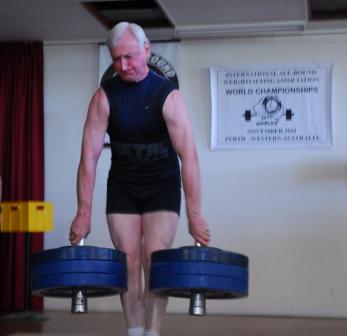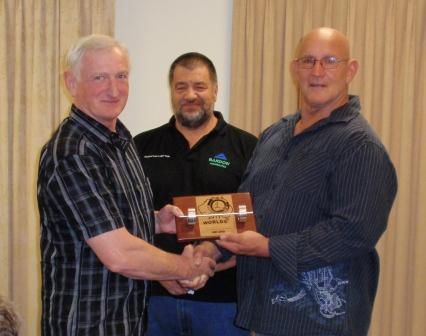by Al Myers

The Overall Best Lifter at the 2011 IAWA World Championships Steve Sherwood also had the TOP LIFT of the meet with his 2-Bar Vertical Bar Deadlift according to the Blindt Formula.
One of the interesting things done by the Australians at the 2011 IAWA World Championships was that they gave an award to the lifter who had the TOP LIFT according to the Blindt Formula. The Blindt Formula is something that we have never really used in the USAWA. It was developed 20 years ago by the English lifter Adrian Blindt. The purpose of the Blindt Formula is to “equalize” all lifts in a meet. Each lift is given a coefficient that is supposed to make the points generated for each lift the same. This Blindt Coefficient is multiplied by the total Lynch Points in a lift to give this new point value. The way we do things is just add the total weight up from the lifts of the day and then apply the Lynch Formula and age correction formula – but by this you can see how it is not really fair to compare a couple of lifts, ie the Hip Lift and the Weaver Stick, if they were in the same meet. A 5 pound increase in the Hip Lift is nothing, but a 5 pound increase in the Weaver Stick is an improbability. However, this concept never really “took hold” in the USAWA or the IAWA(UK). I do believe the English do have a couple of meets that use the Blindt Formula, but it has never been part of the IAWA World Championships.
Of course, “putting a number” on the Blindt Coefficient can still be a debatable point. Also, I could see how the original Blindt Coefficient might not “hold up” after the lift is practiced more and lifters became more proficient at it. In the Highland Games in the RMSA (Rocky Mountain Scottish Athletes), a decathlon scoring system is used in most games. Each event generates points based on a factor which is supposed to “level the playing field” and make each event worth similar points. However, during the late 90s and early 2000s throwers made a major change in throwing technique with the sheaf (went from the push to the swing, to eventually the spin). With these changes in sheaf techiques, much higher heights were reached, thus making this event weighted much more than the other events when points were added up. I felt it made the sheaf points worth at least an event and a half, thus making the sheaf a “more important” event than the others when this scoring system was used. These same problems could happen with the Blindt Formula.
Years ago the Blindt Formula was used in the IAWA World Postal Meet. This World Postal Meet was directed under the promotion of the Australians as well. It is the only time I have been involved in a meet where the Blindt Formula was used until at this World Meet, when it was being used for this “special award”. I really liked the idea of this award, and commend the Australians for presenting this award as it gave “unique flavor” to the awards presentation. I was very curious – just WHAT would be the best lift of the meet? Especially considering all the great lifts that were done by the outstanding lifters in attendance. I took some time and “looked over” the result sheet because it also listed the Blindt scores (but they were NOT used in the overall standings). It was very interesting to say the least. These are the Blindt Coefficients that were assigned to the lifts contested at the World Meet: Vertical Bar Deadlift – .7500, One Hand Swing – 1.5385, Continental Clean and Jerk – .7143, Fulton Bar Deadlift – .6620, Push Press from Rack – .8357, Cheat Curl – 1.0068, and Zercher – .5419. Just how do you think the final standings of the BEST LIFTS of the day would look like? The score of 100 is a PERFECT SCORE, which probably was the basis of the original point formulation. I would consider anything over 90 to be EXCELLENT in a lift when it comes to the Blindt Score, so that is the only lifts I selected for the list below.
TOP LIFTS AT WORLDS ACCORDING TO THE BLINDT FORMULA
| Rank |
Blindt Score |
Lifter |
Event |
| 1 |
128.3 |
Steve Sherwood |
VB Deadlift |
| 2 |
117.2 |
Steve Sherwood |
Fulton DL |
| 3 |
106.9 |
Al Myers |
VB Deadlift |
| 4 |
106.7 |
Mark Haydock |
VB Deadlift |
| 5 |
100.7 |
Tom Edwards |
VB Deadlift |
| 6 |
99.9 |
Peter Phillips |
VB Deadlift |
| 7 |
95.7 |
Steve Sherwood |
Zercher |
| 8 |
95.6 |
Kris McIntyre |
VB Deadlift |
| 9 |
95.3 |
Steve Sherwood |
Swing |
| 10 |
95.2 |
Denny Habecker |
VB Deadlift |
| 11 |
94.8 |
Steve Sherwood |
Cheat Curl |
| 12 |
93.7 |
Peter Phillips |
Swing |
| 13 |
92.9 |
Mark Haydock |
Zercher |
| 14 |
92.8 |
Al Myers |
Zercher |
| 15 |
92.7 |
Frank Allen |
Fulton DL |
| 16 |
92.3 |
Robin Lukosius |
VB Deadlift |
It doesn’t take much of an analysis to realize that the Vertical Bar Deadlift is recognized MUCH MORE than the other lifts in this list. A couple of the lifts (Continental Clean & Jerk and the Push Press from the Rack) were not represented AT ALL in the list of top Blindt lifts. There were some outstanding lifts in these two lifts as well and at least the TOP LIFT in them should have made the list. It makes one wonder that the Blindt Coefficients don’t accurately correlate between different lifts. This list doesn’t reflect record lifts, but only the lifts that counted in competition. I would argue against the use of using the Blindt Formula based on these results, or at least until the coefficients are re-figured to provide a CURRENT and ACCURATE reflection of the proficiency of the lifts in question. But one thing is for certain, even if the Blindt Formula was used in the overall scoring Steve Sherwood would have remained as the TOP LIFTER in the World Championships. He made the list in 5 different lifts!!!!




